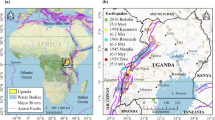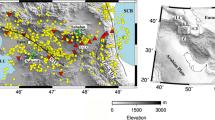Abstract
A new method of dynamic estimate of seismic danger is presented which is based on estimating multifractal properties of low-frequency seismic noise. The efficiency of the method is illustrated by the analysis of seismic noise from broadband seismic network F-net in Japan. The analysis of multifractal properties of low-frequency seismic noise from Japan seismic network F-net since the beginning of 1997 allowed a hypothesis about approaching Japan Islands to a future seismic catastrophe to be formulated at the middle of 2008. The base for such a hypothesis was statistically significant decreasing of multi-fractal singularity spectrum support width mean value. The peculiarities of correlation coefficient estimate within 1 year time window between median values of singularity spectra support width and generalized Hurst exponent allowed to make a decision that starting from July 2010, Japan come to the state of waiting strong earthquake. This prediction of Tohoku mega-earthquake, initially with estimate of lower magnitude as 8.3 only (at the middle of 2008) and further on with estimate of the time beginning of waiting earthquake (from the middle of 2010), was published in advance in a number of scientific articles and abstracts on international conferences. The analysis of seismic noise data after Tohoku mega-earthquake indicates increasing probability of the 2nd strong earthquake within the region where the north part of Philippine Sea plate is approaching island Honshu (Nankai Trough). This region is characterized by relatively low values of singularity spectrum support width which is an indicator of seismic danger. In one paper (Sobolev in Izv Phys Solid Earth 47:1034–1044, 2011), the low-frequency seismic noise at the same range of periods was investigated retrospectively using data from the stations of broadband network IRIS which are located around the epicenter of Tohoku mega-earthquake with a distance up to 1,200 km. It was shown that the variance of the noise and the number of high-amplitude asymmetric impulses were grown dramatically before the event for stations which are located within the radius up to 500 km from the epicenter.









Similar content being viewed by others
References
Feder J (1988) Fractals. Plenum Press, New York
Hirata T, Satoh T, Ito K (1987) Fractal structure of spatial distribution of microfacturing in rock. Geophys J Roy Astron Soc 90(2):369–377
Huber PJ (1981) Robust statistics. Wiley, New York
Humeaua A, Chapeau-Blondeau F, Rousseau D, Rousseau P, Trzepizur W, Abraham P (2008) Multifractality, sample entropy, and wavelet analyses for age-related changes in the peripheral cardiovascular system: preliminary results. Med Phys 35(2):717–727 (American Association of Physicists in Medicine)
Ivanov PCh, Amaral LAN, Goldberger AL, Havlin S, Rosenblum MB, Struzik Z, Stanley HE (1999) Multifractality in healthy heartbeat dynamics. Nature 399:461–465
Kantelhardt JW, Zschiegner SA, Konscienly-Bunde E, Havlin S, Bunde A, Stanley HE (2002) Multifractal detrended fluctuation analysis of nonstationary time series. Physica A 316:87–114
Kobayashi N, Nishida K (1998) Continuous excitation of planetary free oscillations by atmospheric disturbances. Nature 395:357–360
Lyubushin AA (2008) Multifractal Properties of Low-Frequency Microseismic Noise in Japan, 1997–2008. Book of abstracts of 7th General Assembly of the Asian Seismological Commission and Japan Seismological Society, Fall meeting, Tsukuba, 24–27 November 2008, p 92
Lyubushin AA (2009) Synchronization trends and rhythms of multifractal parameters of the field of low-frequency microseisms. Izv Phys Solid Earth 45(5):381–394
Lyubushin AA (2010a) Synchronization of multifractal parameters of regional and global low-frequency microseisms—European Geosciences Union General Assembly 2010, Vienna, 02–07 of May, 2010, Geophysical Research Abstracts, vol 12, EGU2010-696
Lyubushin AA (2010b) Synchronization phenomena of low-frequency microseisms. European Seismological Commission, 32nd General Assembly, September 06–10, 2010, Montpelier. Book of abstracts, session ES6, p 124
Lyubushin AA (2010c) The statistics of the time segments of low-frequency microseisms: trends and synchronization. Izv Phys Solid Earth 46(6):544–554
Lyubushin A (2010d) Multifractal parameters of low-frequency microseisms. In: de Rubeis V et al. (eds) Synchronization and triggering: from fracture to earthquake processes, geoplanet: earth and planetary sciences 1, doi:10.1007/978-3-642-12300-9_15, Springer, Berlin, p 388, Chapter 15, pp 253–272
Lyubushin AA (2011a) Cluster analysis of low-frequency microseismic noise. Izv Phys Solid Earth 47(6):488–495 (submitted in April of 2010)
Lyubushin AA (2011b) Seismic catastrophe in Japan on March 11, 2011: long-term prediction on the basis of low-frequency microseisms. Izv Atmo Ocean Phys 46(8):904–921
Mandelbrot BB (1982) The fractal geometry of nature. Freeman and Co., New York
Pavlov AN, Anishchenko VS (2007) Multifractal analysis of complex signals. Phys Uspekhi 50(8):819–834
Rao CR (1965) Linear statistical inference and its applications. Wiley, NY
Rhie J, Romanowicz B (2004) Excitation of Earth’s continuous free oscillations by atmosphere-ocean-seafloor coupling. Nature 431:552–554
Sobolev GA (2011) Low frequency seismic noise before a magnitude 9.0 Tohoku earthquake on March 11, 2011. ISSN 1069_3513, Izv Phys Solid Earth 47(12):1034–1044
Tanimoto T (2001) Continuous free oscillations: atmosphere-solid earth coupling. Annu Rev Earth Planet Sci 29:563–584
Tanimoto T (2005) The oceanic excitation hypothesis for the continuous oscillations of the Earth. Geophys J Int 160:276–288
Taqqu MS (1988) Self-similar processes encyclopedia of statistical sciences, vol 8. Wiley, New York, pp 352–357
Turcotte DL (1997) Fractals and Chaos in Geology and Geophysics, 2nd edn. Cambridge University Press, New York
Ziganshin AR and Pavlov AN (2005) Scaling properties of multimode dynamics in coupled chaotic oscillators. Proceeding of 2-nd International Conference “Physics and Control”(August 24–26, 2005, S. Petersburg). Saint Petersburg, pp 180–183
Acknowledgments
This work was supported by the Russian Foundation for Basic Research (project no. 12-05-00146).
Author information
Authors and Affiliations
Corresponding author
Rights and permissions
About this article
Cite this article
Lyubushin, A.A. Dynamic estimate of seismic danger based on multifractal properties of low-frequency seismic noise. Nat Hazards 70, 471–483 (2014). https://doi.org/10.1007/s11069-013-0823-7
Received:
Accepted:
Published:
Issue Date:
DOI: https://doi.org/10.1007/s11069-013-0823-7




